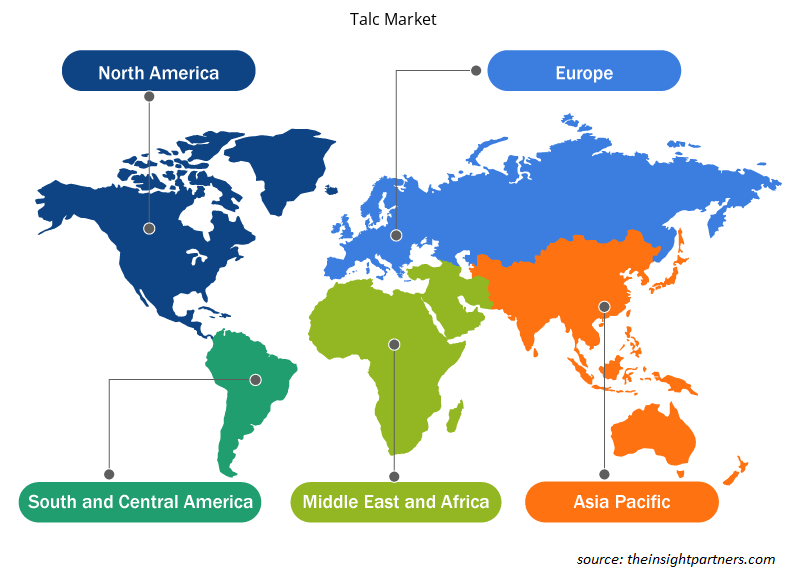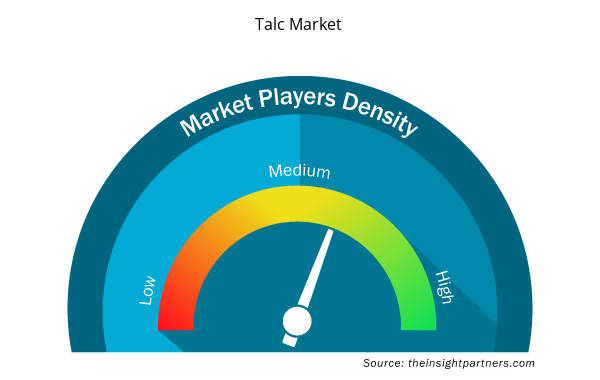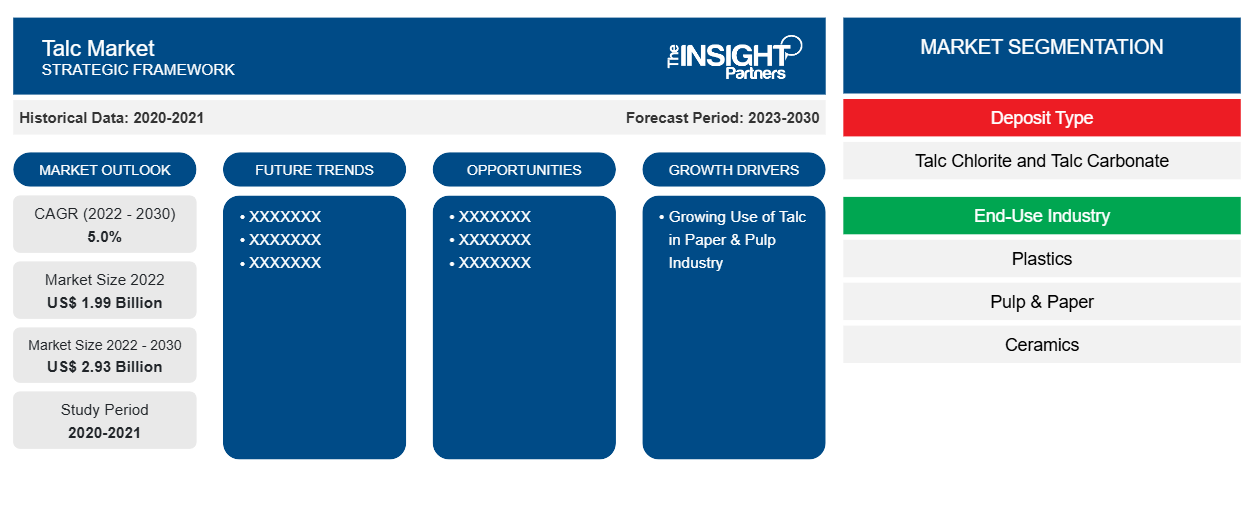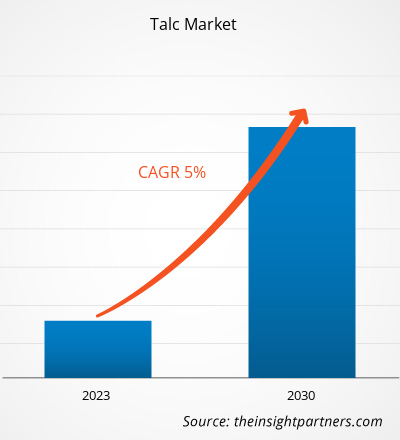[研究报告] 滑石市场规模预计将从 2022 年的 19.8743 亿美元增长到 2030 年的 29.3229 亿美元;预计 2022 年至 2030 年的复合年增长率为 5.0%。
市场洞察和分析师观点:
滑石是一种水合镁硅酸盐。滑石矿床是由高镁岩石经硅质热液转化而形成的。大部分滑石源自白云石或超镁铁质侵入岩的蚀变。它总是与其他矿物(通常是碳酸盐和绿泥石)一起出现。每种滑石矿床都有独特的形态和矿物学,但所有类型的滑石都具有以下独特特性:柔软、防水、化学惰性、片状和对有机物质的亲和性。这些特性使滑石适合用作多功能填料和加工助剂,广泛应用于从塑料到纸张、从陶瓷到油漆等各种应用。滑石可用作防粘剂、防结块剂、润滑剂、载体、增稠剂、强化填料、光滑填料和吸附剂。滑石市场增长的主要驱动力是陶瓷、塑料、油漆和涂料、食品和农业等各种终端行业的需求不断增长。陶瓷行业是全球滑石市场最具吸引力的行业,为市场创造了丰厚的利润。塑料行业是滑石的另一个重要消费行业。滑石主要用作塑料中的填料。
增长动力和挑战:
滑石通常用作纸浆和造纸工业中的沥青控制剂、涂层颜料和功能性填料。它有助于提高造纸机的运行性能。滑石用于回收纸张并生产新的纸张、纸浆和纸板。滑石的特性可防止生产机器内的沥青聚集。滑石用作填料,使纸张光滑、多孔和不透明。此外,在造纸过程中,使用滑石可提高成品质量并降低生产成本。此外,滑石还用于各种终端行业,如油漆和涂料、塑料、农业和食品。在油漆工业中,使用滑石可减少油漆生产中原颜料的使用,从而降低制造成本。滑石可增强漆膜并提高油漆的耐久性和抗污性。由于其防锈和耐腐蚀特性,涂饰效果更持久。此外,滑石作为增量剂可增加油漆的粘度。建筑、汽车和工业领域的强劲增长推动了对油漆和涂料的需求。滑石是从地球上开采出来的。它可能含有石棉,这是一种剧毒物质。石棉存在于地下,其矿脉通常可以在滑石矿床中找到,从而导致交叉污染的风险。因此,不同产品中存在受石棉污染的滑石的可能性很高。长期接触石棉会增加患癌症的风险,尤其是间皮瘤(肺癌)、卵巢癌和喉癌。
定制此报告以满足您的需求
您可以免费定制任何报告,包括本报告的部分内容、国家级分析、Excel 数据包,以及为初创企业和大学提供优惠和折扣
- 获取此报告的关键市场趋势。这个免费样品将包括数据分析,从市场趋势到估计和预测。
报告细分和范围:
全球滑石市场根据矿床类型和最终用途行业进行划分。根据矿床类型,滑石市场分为滑石绿泥石和滑石碳酸盐。根据最终用途行业,滑石市场分为塑料、纸浆和造纸、陶瓷、油漆和涂料、橡胶、制药、食品等。按地域划分,全球滑石市场大致分为北美、欧洲、亚太地区、中东和非洲以及南美和中美洲。北美滑石市场进一步细分为美国、加拿大和墨西哥。欧洲市场细分为德国、法国、英国、意大利、俄罗斯和欧洲其他地区。亚太滑石市场进一步细分为中国、印度、日本、澳大利亚、韩国和亚太其他地区。中东和非洲市场进一步细分为南非、沙特阿拉伯、阿联酋以及中东和非洲其他地区。南美和中美滑石市场进一步细分为巴西、阿根廷和南美和中美其他地区。
节段分析:
根据矿床类型,滑石市场细分为滑石绿泥石和滑石碳酸盐。滑石碳酸盐部分在 2022 年占据了更大的市场份额。滑石碳酸盐矿体主要含有滑石碳酸盐和绿泥石痕迹。这些矿床通常存在于变质岩中,可被视为变质矿床的亚型。在滑石碳酸盐矿床中,滑石的形成通常与富含镁矿物的现有岩石的交替有关。滑石在变质条件的影响下取代了这些矿物,从而形成了富含滑石的岩石。滑石碳酸盐矿石经过加工以去除相关矿物并生产出纯滑石精矿。根据最终用途行业,滑石市场细分为塑料、纸浆和造纸、陶瓷、油漆和涂料、橡胶、制药、食品等。 2022 年,滑石在纸浆和造纸领域的市场份额非常可观。在纸浆和造纸行业,滑石被用作纸张填料,因为它对纸张强度的负面影响很小,但可以大大提高油墨的接受性。它还可以提高不透明度和亮度并降低光泽度。滑石可用作纸张回收和新纸、纸浆和纸板生产的填料。使用滑石可以改善成品的性能并降低生产成本。
区域分析:
滑石市场分为五个主要区域——北美、欧洲、亚太、南美和中美以及中东和非洲。亚太地区主导着全球滑石市场,2022 年市场规模约为 9.5 亿美元。北美也是一个主要贡献者,在全球滑石市场占有相当大的份额。预计到 2030 年,北美滑石市场规模将超过 3 亿美元。预计 2022 年至 2030 年期间欧洲的复合年增长率将超过 5%。澳大利亚、中国、印度、日本和韩国是亚太地区滑石市场的主要贡献者。亚太地区是全球最大的粗滑石和加工滑石生产区之一。该地区是生产汽车零部件轻质塑料的主要制造商的所在地。新兴经济体的快速工业化和中产阶级人口可支配收入的激增预计将推动亚太地区对滑石的需求。根据国际汽车制造商组织(OICA)的数据,亚洲-大洋洲地区的汽车产量从2020年的4420万辆增加到2021年的4670万辆。
行业发展和未来机遇:
以下列出了滑石市场主要参与者采取的各种举措:
- 2021 年 2 月,Magris Resources Canada Inc. 宣布已签署最终的先导协议,以收购 Imerys Talc America Inc.、Imerys Talc Vermont Inc. 和 Imerys Talc Canada Inc. 的几乎所有资产。
滑石市场区域洞察
Insight Partners 的分析师已详尽解释了预测期内影响滑石粉市场的区域趋势和因素。本节还讨论了北美、欧洲、亚太地区、中东和非洲以及南美和中美洲的滑石粉市场细分和地理位置。

- 获取滑石市场的区域特定数据
滑石市场报告范围
| 报告属性 | 细节 |
|---|---|
| 2022 年市场规模 | 19.9亿美元 |
| 2030 年市场规模 | 29.3亿美元 |
| 全球复合年增长率(2022 - 2030 年) | 5.0% |
| 史料 | 2020-2021 |
| 预测期 | 2023-2030 |
| 涵盖的领域 | 按存款类型
|
| 覆盖地区和国家 | 北美
|
| 市场领导者和主要公司简介 |
|
市场参与者密度:了解其对商业动态的影响
滑石市场正在快速增长,这得益于终端用户需求的不断增长,而这些需求又源于消费者偏好的不断变化、技术进步以及对产品优势的认识不断提高等因素。随着需求的增加,企业正在扩大其产品范围,进行创新以满足消费者的需求,并利用新兴趋势,从而进一步推动市场增长。
市场参与者密度是指在特定市场或行业内运营的企业或公司的分布情况。它表明相对于给定市场空间的规模或总市场价值,有多少竞争对手(市场参与者)存在于该市场空间中。
在滑石市场运营的主要公司有:
- 海名斯股份有限公司
- 戈尔查矿产私人有限公司
- 意瑞石公司
- IMI Fabi SpA
- 辽宁艾海滑石有限公司
免责声明:上面列出的公司没有按照任何特定顺序排列。

- 获取滑石粉市场顶级关键参与者概述
COVID-19 疫情影响:
COVID-19 疫情对各国几乎所有行业都产生了不利影响。北美、欧洲、亚太地区 (APAC)、南美和中美 (SAM) 以及中东和非洲 (MEA) 的封锁、企业停工和旅行限制阻碍了多个行业的增长,包括化学和材料行业。制造部门的关闭扰乱了全球供应链、制造活动、交付计划以及必需品和非必需品销售。多家公司报告称,2020 年产品交付延迟,产品销售下滑。由于疫情引发的经济衰退,消费者在购买决策方面变得谨慎和挑剔。由于收入较低和收入前景不确定,消费者大幅减少了非必需品购买,尤其是在发展中地区。许多滑石粉制造商报告称,由于疫情初期消费者需求减少,利润下降。然而,到 2021 年底,许多国家都已全面接种疫苗,政府宣布放宽某些规定,包括封锁和旅行禁令。人口的可支配收入不断增加,因此人们更加注重购买新家具和装修,从而推动了对滑石粉的需求。所有这些因素都推动了不同地区滑石粉市场的增长。
竞争格局和重点公司:
Elementis Plc、Golcha Minerals Pvt Ltd、Imerys SA、IMI Fabi SpA、辽宁艾海滑石有限公司、Minerals Technologies Inc、Nippon Talc Co Ltd、SCR-Sibelco NV、Sun Minerals Pvt Ltd 和 Xilolite SA 是全球滑石市场上的知名企业。这些企业提供高品质滑石,满足全球众多消费者的需求。
- 历史分析(2 年)、基准年、预测(7 年)及复合年增长率
- PEST 和 SWOT 分析
- 市场规模价值/数量 - 全球、区域、国家
- 行业和竞争格局
- Excel 数据集


- Non-Emergency Medical Transportation Market
- Rare Neurological Disease Treatment Market
- Fishing Equipment Market
- Artificial Turf Market
- Small Molecule Drug Discovery Market
- Rugged Servers Market
- Genetic Testing Services Market
- Medical Collagen Market
- Legal Case Management Software Market
- Constipation Treatment Market

Report Coverage
Revenue forecast, Company Analysis, Industry landscape, Growth factors, and Trends

Segment Covered
This text is related
to segments covered.

Regional Scope
North America, Europe, Asia Pacific, Middle East & Africa, South & Central America

Country Scope
This text is related
to country scope.
常见问题
The major players operating in the talc market are Elementis Plc, Golcha Minerals Pvt Ltd, Imerys SA, IMI Fabi SpA, Liaoning Aihai Talc Co Ltd, Minerals Technologies Inc, Nippon Talc Co Ltd, SCR-Sibelco NV, Sun Minerals Pvt Ltd, and Xilolite SA.
In 2022, the talc carbonate segment held the largest market share. Talc carbonate provides lower viscosity and better scrub resistance than other talc types. The carbonate deposits are widely used in the paints & coatings, construction, cosmetics, and personal care industries. These factors led to the dominance of the talc carbonate segment in 2022.
During the forecast period, ceramics is expected to be the fastest-growing segment. Talc improves the firing characteristics and strengthens the finished product. Therefore, it is used as a filler in automotive cordierite, several tiles, and fireproof ceramics. Talc is a catalyst in the ceramic industry and has a high-temperature resistance. Adding talc enhances the mechanical and optical properties of the ceramic material and glazes, and the combustion temperature is reduced. These benefits positively impact production costs of ceramics. These factors are expected to boost the growth of the ceramics segment in the talc market demand during the forecast period.
In 2022, the pulp & paper segment held the largest market share. In the pulp & paper industry, talc is used as a paper filler, since it has a minimal negative effect on sheet strength but improves ink receptivity by a large margin. It also enhances opacity and brightness and reduces gloss. Talc can be used in paper recycling and the new production of paper, pulp, and cardboard as filler. Talc use improves the properties of the finished products and reduces production costs. These factors led to the dominance of the pulp & paper segment in 2022.
Talc is used in various end-use industries such as paints & coatings, plastics, agriculture, and food. In the paint industry, talc use reduces the use of primary pigment in paint production, which reduces manufacturing costs. Talc reinforces the paint film and improves the durability and stain resistance of paint. Owing to its rust-inhibitive and corrosion-resistance properties, the finish lasts longer. Also, talc as an extender increases the viscosity of a paint. The strong growth of the construction, automotive, and industrial sectors propel demand for paints and coatings. These factors are driving the talc market growth.
In 2022, Asia Pacific accounted for the largest share of the global talc market. The demand for talc in Asia Pacific is increasing due to the growing use of talc in ceramics and paint & coatings. The growing building & construction industry led to the dominance of Asia Pacific in 2022.
Trends and growth analysis reports related to Chemicals and Materials : READ MORE..
The List of Companies - Talc Market
- Elementis Plc
- Golcha Minerals Pvt Ltd
- Imerys SA
- IMI Fabi SpA
- Liaoning Aihai Talc Co Ltd
- Minerals Technologies Inc
- Nippon Talc Co Ltd
- SCR-Sibelco NV
- Sun Minerals Pvt Ltd
- Xilolite SA
The Insight Partners performs research in 4 major stages: Data Collection & Secondary Research, Primary Research, Data Analysis and Data Triangulation & Final Review.
- Data Collection and Secondary Research:
As a market research and consulting firm operating from a decade, we have published and advised several client across the globe. First step for any study will start with an assessment of currently available data and insights from existing reports. Further, historical and current market information is collected from Investor Presentations, Annual Reports, SEC Filings, etc., and other information related to company’s performance and market positioning are gathered from Paid Databases (Factiva, Hoovers, and Reuters) and various other publications available in public domain.
Several associations trade associates, technical forums, institutes, societies and organization are accessed to gain technical as well as market related insights through their publications such as research papers, blogs and press releases related to the studies are referred to get cues about the market. Further, white papers, journals, magazines, and other news articles published in last 3 years are scrutinized and analyzed to understand the current market trends.
- Primary Research:
The primarily interview analysis comprise of data obtained from industry participants interview and answers to survey questions gathered by in-house primary team.
For primary research, interviews are conducted with industry experts/CEOs/Marketing Managers/VPs/Subject Matter Experts from both demand and supply side to get a 360-degree view of the market. The primary team conducts several interviews based on the complexity of the markets to understand the various market trends and dynamics which makes research more credible and precise.
A typical research interview fulfils the following functions:
- Provides first-hand information on the market size, market trends, growth trends, competitive landscape, and outlook
- Validates and strengthens in-house secondary research findings
- Develops the analysis team’s expertise and market understanding
Primary research involves email interactions and telephone interviews for each market, category, segment, and sub-segment across geographies. The participants who typically take part in such a process include, but are not limited to:
- Industry participants: VPs, business development managers, market intelligence managers and national sales managers
- Outside experts: Valuation experts, research analysts and key opinion leaders specializing in the electronics and semiconductor industry.
Below is the breakup of our primary respondents by company, designation, and region:

Once we receive the confirmation from primary research sources or primary respondents, we finalize the base year market estimation and forecast the data as per the macroeconomic and microeconomic factors assessed during data collection.
- Data Analysis:
Once data is validated through both secondary as well as primary respondents, we finalize the market estimations by hypothesis formulation and factor analysis at regional and country level.
- Macro-Economic Factor Analysis:
We analyse macroeconomic indicators such the gross domestic product (GDP), increase in the demand for goods and services across industries, technological advancement, regional economic growth, governmental policies, the influence of COVID-19, PEST analysis, and other aspects. This analysis aids in setting benchmarks for various nations/regions and approximating market splits. Additionally, the general trend of the aforementioned components aid in determining the market's development possibilities.
- Country Level Data:
Various factors that are especially aligned to the country are taken into account to determine the market size for a certain area and country, including the presence of vendors, such as headquarters and offices, the country's GDP, demand patterns, and industry growth. To comprehend the market dynamics for the nation, a number of growth variables, inhibitors, application areas, and current market trends are researched. The aforementioned elements aid in determining the country's overall market's growth potential.
- Company Profile:
The “Table of Contents” is formulated by listing and analyzing more than 25 - 30 companies operating in the market ecosystem across geographies. However, we profile only 10 companies as a standard practice in our syndicate reports. These 10 companies comprise leading, emerging, and regional players. Nonetheless, our analysis is not restricted to the 10 listed companies, we also analyze other companies present in the market to develop a holistic view and understand the prevailing trends. The “Company Profiles” section in the report covers key facts, business description, products & services, financial information, SWOT analysis, and key developments. The financial information presented is extracted from the annual reports and official documents of the publicly listed companies. Upon collecting the information for the sections of respective companies, we verify them via various primary sources and then compile the data in respective company profiles. The company level information helps us in deriving the base number as well as in forecasting the market size.
- Developing Base Number:
Aggregation of sales statistics (2020-2022) and macro-economic factor, and other secondary and primary research insights are utilized to arrive at base number and related market shares for 2022. The data gaps are identified in this step and relevant market data is analyzed, collected from paid primary interviews or databases. On finalizing the base year market size, forecasts are developed on the basis of macro-economic, industry and market growth factors and company level analysis.
- Data Triangulation and Final Review:
The market findings and base year market size calculations are validated from supply as well as demand side. Demand side validations are based on macro-economic factor analysis and benchmarks for respective regions and countries. In case of supply side validations, revenues of major companies are estimated (in case not available) based on industry benchmark, approximate number of employees, product portfolio, and primary interviews revenues are gathered. Further revenue from target product/service segment is assessed to avoid overshooting of market statistics. In case of heavy deviations between supply and demand side values, all thes steps are repeated to achieve synchronization.
We follow an iterative model, wherein we share our research findings with Subject Matter Experts (SME’s) and Key Opinion Leaders (KOLs) until consensus view of the market is not formulated – this model negates any drastic deviation in the opinions of experts. Only validated and universally acceptable research findings are quoted in our reports.
We have important check points that we use to validate our research findings – which we call – data triangulation, where we validate the information, we generate from secondary sources with primary interviews and then we re-validate with our internal data bases and Subject matter experts. This comprehensive model enables us to deliver high quality, reliable data in shortest possible time.


 获取此报告的免费样本
获取此报告的免费样本